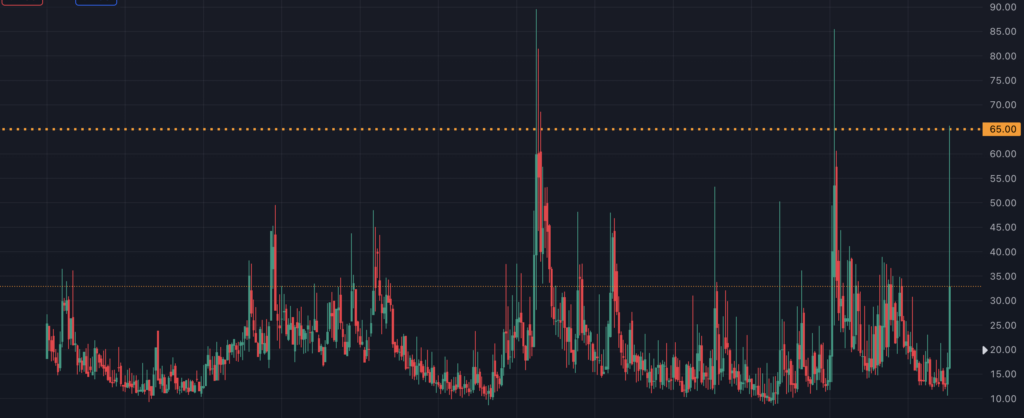VIX Hits 65: What Does It Mean This Time?

For only the third time ever, the VIX, also known as the “fear gauge,” has crossed the value of 65. This is a significant event, and it has deep implications for the financial markets and investors. Let’s dive into why this is important and how it compares to the two previous instances when the VIX spiked to such high levels.
See here for an introduction to the VIX
The first time the VIX spiked above 65 was during the 2008 financial crisis. This was a period of extreme turmoil in global financial markets, triggered primarily by the collapse of Lehman Brothers, a major investment bank. The crisis was caused by a combination of factors, including excessive risk-taking by banks, the bursting of the housing bubble, and the subsequent collapse of mortgage-backed securities.
Data from 2008
- Lehman Brothers Collapse: Lehman Brothers filed for bankruptcy on September 15, 2008, leading to a massive sell-off in the global stock markets.
- Stock Market Decline: The Dow Jones Industrial Average fell by more than 700 points on the day of the Lehman Brothers collapse.
- VIX Surge: The VIX surged to a record high of 89.53 on October 24, 2008, reflecting the extreme fear and uncertainty in the market.
- Unemployment Rates: The U.S. unemployment rate peaked at 10% in October 2009, illustrating the severe economic impact of the crisis.
The 2008 financial crisis led to a global recession, with economies around the world contracting, unemployment rates soaring, and stock markets plummeting. Governments and central banks had to intervene with unprecedented measures, including bailouts and monetary stimulus, to stabilize the financial system.
The second time the VIX crossed the 65 mark was during the COVID-19 pandemic in 2020. The pandemic led to widespread lockdowns, halting economic activity worldwide and causing a sharp contraction in global GDP. The uncertainty about the virus’s spread, the effectiveness of lockdown measures, and the potential duration of the pandemic led to extreme volatility in the financial markets.
Supporting Data from 2020
- Market Crash: In March 2020, the S&P 500 experienced its fastest drop into a bear market in history, losing over 30% of its value in just a few weeks.
- VIX Surge: The VIX hit a peak of 82.69 on March 16, 2020, as investors grappled with the unknowns surrounding the pandemic.
- Economic Impact: The IMF estimated that the global economy contracted by 3.5% in 2020, with advanced economies shrinking by 4.9%.
- Unemployment Rates: The U.S. unemployment rate soared to 14.8% in April 2020, the highest level since the Great Depression.
Governments and central banks responded with massive stimulus packages, including direct payments to individuals, expanded unemployment benefits, and significant monetary easing, to mitigate the economic impact of the pandemic.
The Current Spike: What’s Different?
Now, in August 2024, the VIX has crossed 65 again. However, what makes this event quite different from the previous two is the lack of a single, clear catalyst. In 2008 and 2020, the spikes in the VIX were reactions to proportionately severe events – the financial crisis and the COVID-19 pandemic, respectively.
Possible Causes?
- Japanese Yen Carry Trade Unwinding: Some speculate that the recent VIX spike could be due to the unwinding of the Japanese yen carry trade. This involves borrowing in yen at low interest rates and investing in higher-yielding assets abroad. If investors start reversing these trades, it can lead to significant market volatility.
- Combination of Factors: It’s also possible that the VIX spike is due to a combination of factors, including AI hype cooling, geopolitical tensions, inflation concerns, and uncertainties about central bank policies.
One key question is whether financial markets are becoming more sensitive to negative events. Unlike the 2008 financial crisis or the 2020 COVID-19 crash, we aren’t currently facing a global financial meltdown or a pandemic. Instead, the market’s reaction might indicate heightened sensitivity to smaller, negative events.
For investors, this heightened sensitivity means that staying informed and being prepared for volatility is more important than ever. Diversification, risk management, and having a long-term perspective are critical strategies to navigate these uncertain times.
The VIX crossing 65 for the third time in history is a significant event. While the previous spikes were due to severe global crises, the current spike seems to be driven by a mix of factors, underscoring the importance of staying vigilant and adaptable in today’s fast-changing financial landscape.
As we move forward, understanding the underlying causes of market volatility and staying prepared for potential risks will be crucial for investors and market participants alike. Whether this marks a new era of increased market sensitivity or is just a temporary spike, only time will tell. But one thing is clear: the financial markets are always full of surprises.





